A quick and tasty Japanese Udon Noodle Soup which takes less than 30 minutes to prepare! Perfect for weeknight dinners.
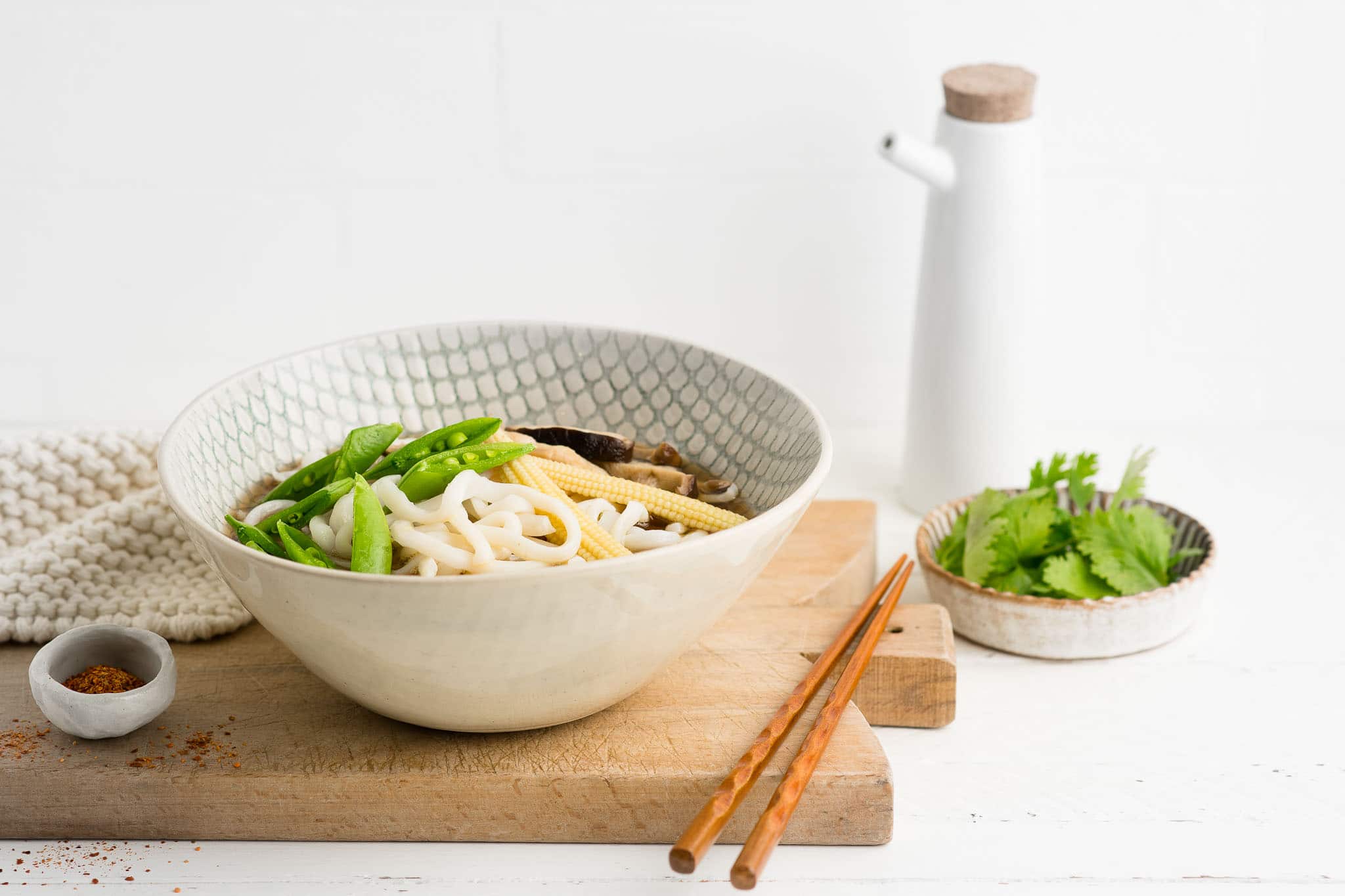
Udon Noodle Soup
Comfort food to me is usually a big bowl of steaming noodle soup, no matter the weather. Even in the midst of a heatwave, you will find me hunched over a bowl of noodles, slurping away happily.
This Japanese Udon Noodle Soup is one of my favourite noodle soups, not least because it takes less than 30 minutes to make, plus it happens to be one of my fridge-raid specials!
Why This Recipe Works
- This udon noodle soup uses dashi powder and takes less than 30 minutes to prepare!
- Use your favourite vegetables or any leftover veges in your fridge.
- Add leftover roast meat or even boiled eggs for added protein.
- Stock up on udon noodles in your pantry, and you will always have a quick meal to hand with this recipe.
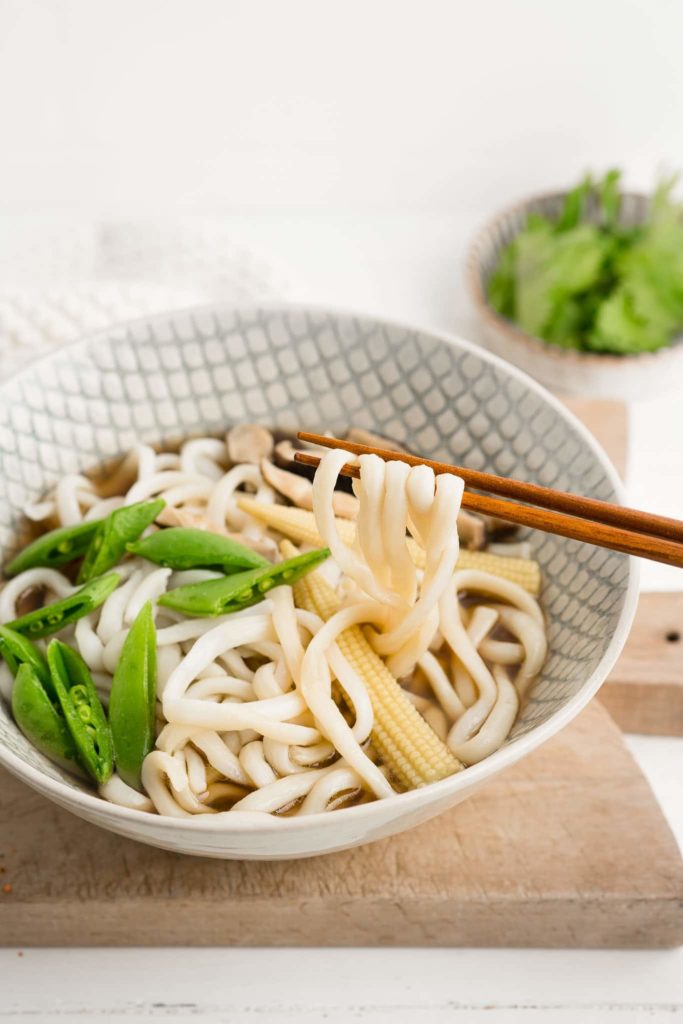
What are Udon Noodles?
Udon noodles originate from Japan and are popular served in soups or stir-fries.
They are made from wheat flour and you will generally recognise them as thick, white noodles which have a soft and chewy texture.
Buying Udon Noodles
Udon noodles are available in three different varieties: dried, vacuum-sealed, and frozen.
Dried udon noodles need to be rehydrated in hot water like most other dried noodles found in Asian cuisine. Dried udon noodles are typically thinner and less chewy than the other varieties.
Vacuum-sealed udon noodles are sold in individually-portioned plastic packets, and which can be found either on the supermarket shelf or in the refrigerated section. These noodles are pre-cooked, but I recommend blanching the noodles briefly in boiling water to loosen the tightly packed noodles.
Frozen udon noodles are sold in large packs in the freezer section. These noodles are also pre-cooked, so you only need to thaw them in a pan of boiling water for 1-2 minutes.
The vacuum-sealed udon noodles have a long shelf-life and are easy to keep on hand in the fridge or pantry, but I think the frozen variety are more superior in taste and texture. The frozen udon noodles have a thicker and chewier texture, but the downside is they take a lot of space in the freezer.
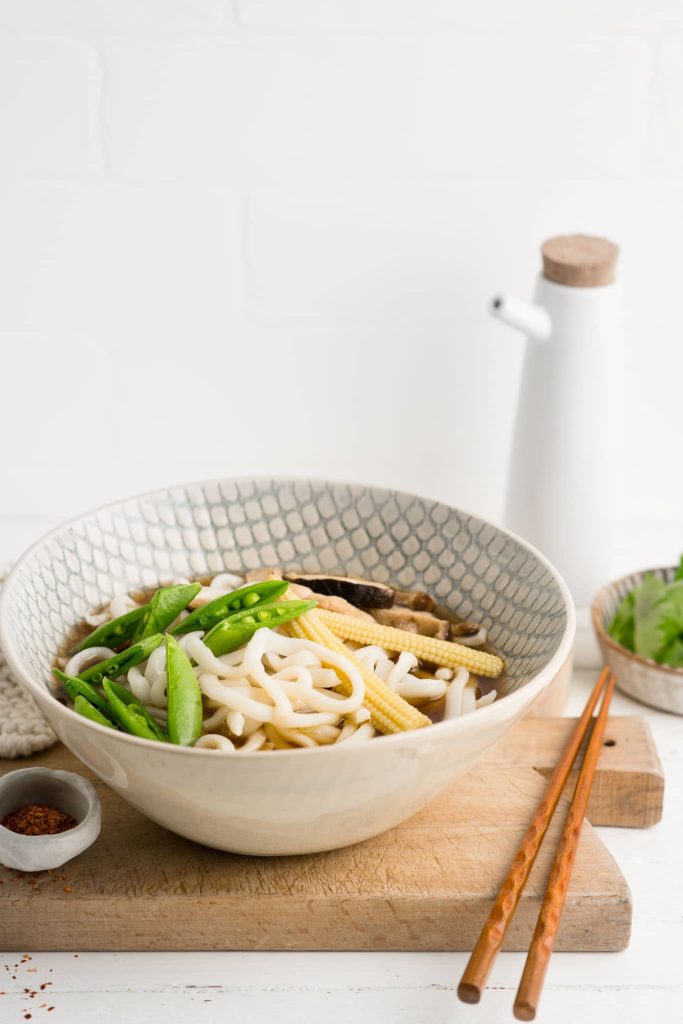
Udon Noodle Soup Recipe
This Udon Noodle Soup is one of my go-to-recipes when I just want a bowl of slippery noodles in a comforting broth. I generally like to keep this soup simple – just noodles and broth – and perhaps I will serve some steamed veges on the side, or maybe even Japanese Fried Chicken for something more substantial.
It also happens to be a great recipe when I need to clear out the vegetable tray in the fridge; you can add almost any vegetable you like directly to the broth, and even toss in some leftover roast meat or even boiled eggs.
As udon noodles are one of my favourite things to eat, I always keep a good supply in the pantry or freezer. Which means I can always make this Udon Noodle Soup at a moment’s notice.
What’s more: I take a shortcut and make the soup base using dashi powder.
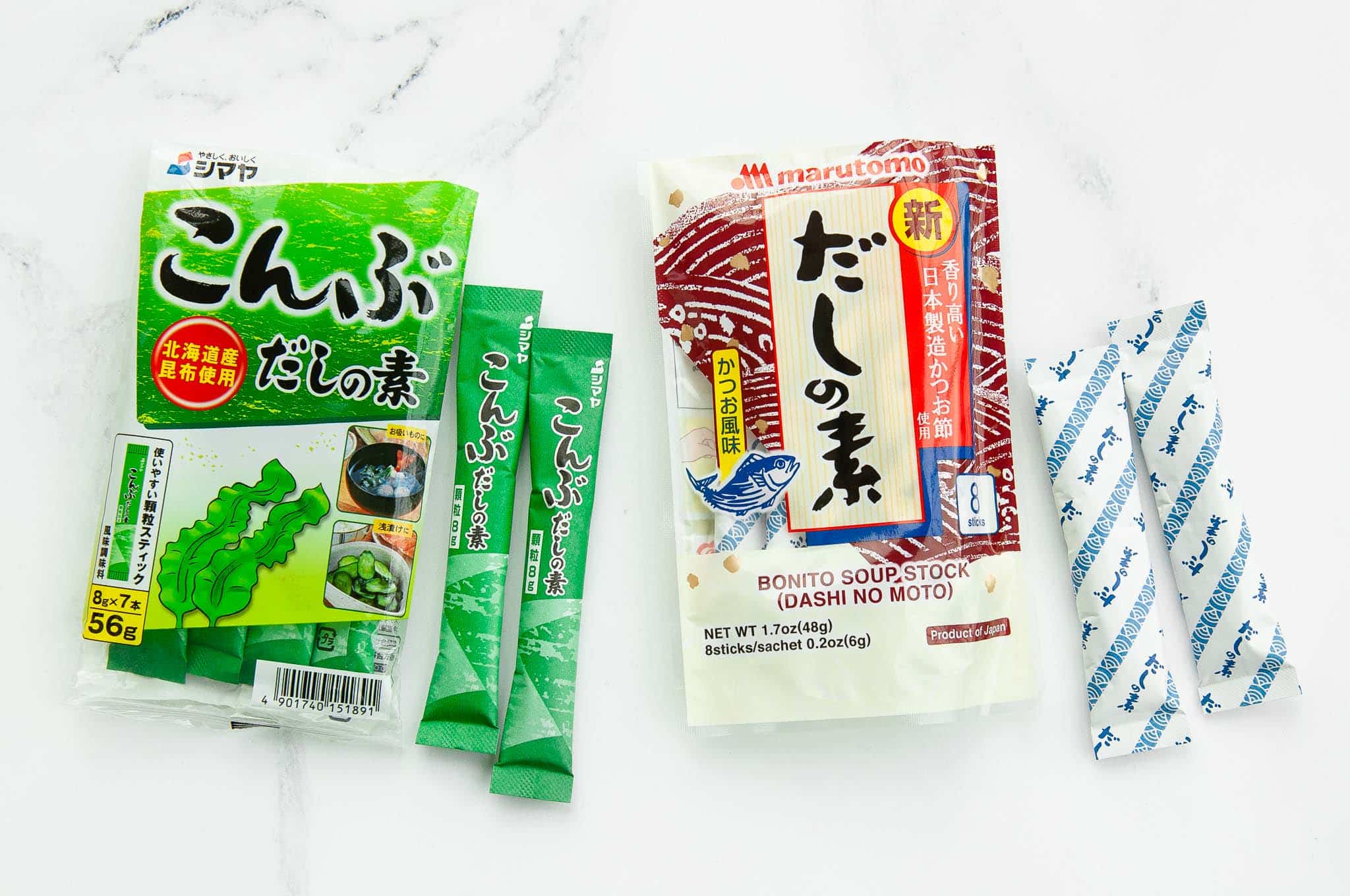
How to Make Dashi Broth Using Dashi Powder
A traditional Japanese udon noodle soup recipe uses dashi, which is a broth containing a few strong-flavoured and umami-packed ingredients to form the flavour base.
Dashi is usually made from one or a combination of the following ingredients:
- Dried kelp
- Dried bonito flakes
- Dried anchovies
- Dried shitake mushrooms
Making your own dashi from scratch is actually quite easy, but you will need at least 30 minutes. It’s mostly a process of simmering the ingredients in a pot of water to extract flavour and then straining the dashi stock before using. Alternatively, you can make dashi by steeping the ingredients in water overnight.
A shortcut method, which is the equivalent of using a stock cube in western cooking, is to use dashi powder. These are available where Japanese groceries are sold, and they are sold in large packets containing individual sachets.
You can find dashi powder in a variety of the above-mentioned flavours. My preference is to use an Awase Dashi, which is a combination of both dried kelp and dried bonito flakes. I think it has a more complex and savoury flavour than the others, but I also like to use just dried kelp or dried shitake mushrooms when I want to keep things vegetarian.
If you can’t find Awase Dashi, you can make your own mix by using 1 sachet of dried kelp dashi and 1 sachet of bonito flake dashi. Or feel free to experiment with the different flavours to find out which ones you like.
Variations
If you love tofu, I recommend this recipe for Kitsune Udon, where the udon noodles are served inside a fried tofu pouch with dashi broth. It’s a fun twist on a simple udon noodle soup!
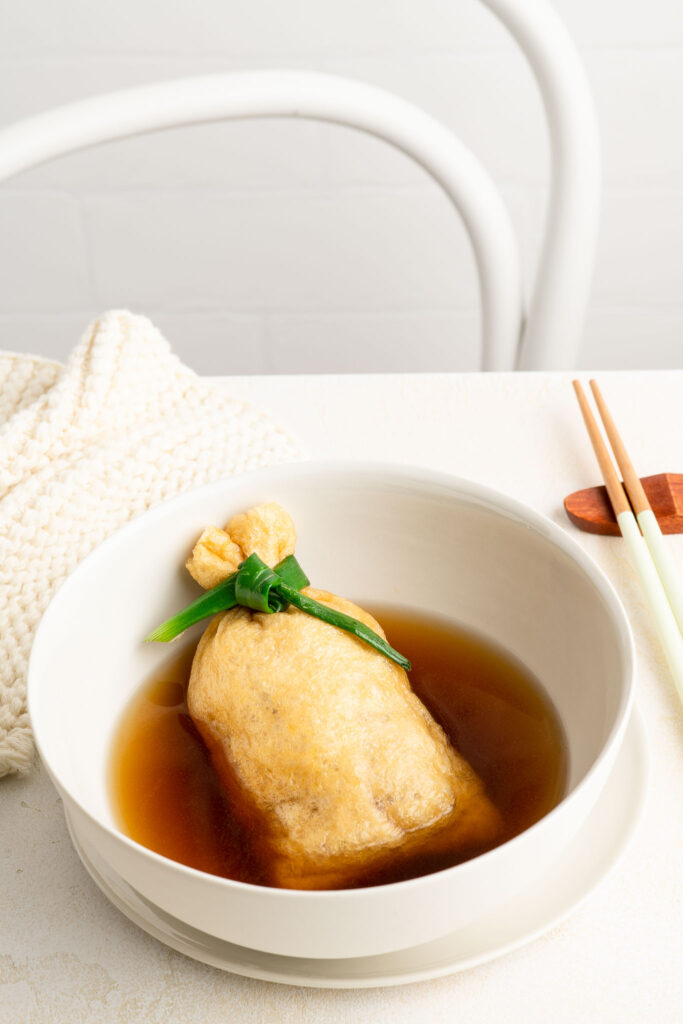
Japanese Udon Noodle Soup
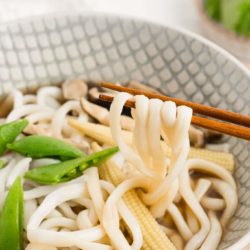
- Prep Time: 10 mins
- Cook Time: 15 mins
- Total Time: 25 minutes
- Yield: Serves 3-4
- Category: Dinner
- Method: Stove Top
- Cuisine: Japanese
A quick and tasty Japanese Udon Noodle Soup which takes less than 30 minutes to prepare! Perfect for weeknight dinners.
Ingredients
For the Noodles
- approx 1 kg (2.2 lb) udon noodles (frozen or vacuum-sealed)
- 1 teaspoon sesame oil
For the Dashi Broth
- 2 litres (8 cups) water
- 2 x 8 g dashi powder
- 2–3 tablespoons soy sauce
- 1 tablespoon mirin
- 1 teaspoon sugar
- 1–2 teaspoons sea salt
To Serve (suggestions)
- 1 large handful fresh shitake mushrooms, sliced
- 5 baby corn, halved lengthwise
- 1 large handful snow peas, halved lengthwise
Instructions
To Prepare the Noodles
- Fill a large saucepan with boiling water.
- Bring the saucepan to the boil on high heat.
- Add the noodles.
- Use a pair of tongs or chopsticks to gently loosen and separate the noodles. This step should take just a few seconds.
- Once the noodles have separated, drain the noodles immediately.
- Add the sesame oil to the noodles and toss briefly. The sesame oil will help prevent the noodles from sticking to each other.
- Divide the noodles amongst the soup bowls.
To Prepare the Dashi Broth
- In a large saucepan, bring the water to a gentle simmer.
- Add the dashi powder, soy sauce, mirin and sugar.
- Simmer the broth gently for about 5 to 10 minutes.
- Taste for seasoning. Add more salt or soy sauce if necessary, or you may need to dilute with more water if the broth is too strong or salty.
To Serve
- Add the vegetables to the broth and cook them for a few minutes.
- Ladle the hot soup over the noodles, together with the vegetables.
- Serve immediately.
Kitchen Notes
 WHICH VEGETABLES TO USE
WHICH VEGETABLES TO USE
You can use whatever vegetables you like in this recipe. Some other suggestions include:
* bok choy or pak choi, sliced if large
* baby spinach
* carrots, sliced thinly
* courgette (zucchini), sliced thickly
* button mushroons, sliced thickly
* broccoli, cut into small florets
 ADD SOME PROTEIN
ADD SOME PROTEIN
Depending on what I have in the fridge, I also love to add:
* leftover roast chicken, sliced or shredded
* silken tofu, cut into large chunks
* hard-boiled egg, sliced in half
 CONVERSIONS
CONVERSIONS
To convert from cups to grams, and vice-versa, please see this handy Conversion Chart for Basic Ingredients.
Update
This recipe was first published on 6 February 2020. It has been updated with more comprehensive recipe notes.
 Print
Print Pin Recipe
Pin Recipe Rate
Rate

Lovely, simple recipe. Sometimes I just want a big bowl of soup with lots of noodles and this recipe is a great comfort food.
Wow this tastes exactly like the udon soup you can get at a restaurant!